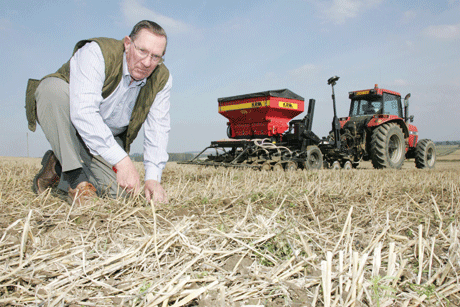Midlands Barometer farmer: No till regime continues for Tony Reynolds

For Tony Reynolds and his son-in-law Clive Patrick, this autumn’s sowing conditions have proved a severe test on the mixed soils they farm near Bourne, Lincolnshire, and their mainly heavier land at Melton Mowbray, Leicestershire.
“We consider that the yields we achieved this year are sufficiently encouraging to continue full-blooded with our no-till system,” says Mr Reynolds, Farmers Weekly Midlands barometer grower. “Nonetheless we’re still looking for the perfect no-till drill, and I’m very interested in seeing every offer that’s on the market.”
The main spur for their move from more conventional establishment methods was not so much to reduce costs as to revive their soils. On much of the land these were becoming increasingly lifeless and losing fertility.
Having embarked on the exercise four years ago with two machines, a 4m Bertini 22.000 and a 6m John Deere 750a, Mr Reynolds recently became particularly interested in the CPH No-Till drills made by US company Great Plains.
“We wanted a 6m one, but the only one available here until next April was a 3m one that had been standing in a shed for some years at KRM, Doncaster – the UK agent.”
The original seed hopper on the imported machine was fitted with a KRM one. And of all the machines used this autumn, including a 3m Sulky Easydrill and a 6m Vaderstad Seed Hawk both on demonstration, it was the most encouraging.
Both the trial drills were tested on normal rape stubble and in standing wheat straw left after combining with the farm’s stripper header.
“We’re very pleased with the overall performance of the Great Plains drill so far,” says Mr Reynolds. “And given that crop emergence is in line with the others I would expect to have a larger machine for next season.”
The Bertini, John Deere and Great Plains machines all sowed into stripped wheat efficiently.
The Sulky coped less well, mainly because there was too little individual movement of its sowing discs, he believes. “It’s a problem we feel could be overcome.”
However, the tines of the Vaderstad made it totally unsuitable for working in stripped wheat. “It pulled every stalk out of the ground and after 20m travel it was impossible to continue forwards.
“As far as travelling in wet conditions the Great Plains drill presented no problems at all. But there was a tendency for the front discs to ride out on sticky soil.”
The rubber wheels on the openers of the John Deere soon filled up in every wet patch, of which there were many, and the Bertini was very prone to blocking in the openers as soon as the ground became damp, he notes.

“Both these last two drills are super in dry conditions. I guess that’s because they’re designed for dry climates, where moisture conservation is a key design feature, rather than for the somewhat damper European conditions.”
Closing the sowing slot well is especially important in a no-till system, stresses Mr Reynolds. “It’s particularly difficult when the soil is ‘leathery’.”
In that respect the Bertini seems to have performed best, creating notably even crop emergence. “It’s very uniform – it all appears on the same day.”
- For more on controlled traffic farming click here

